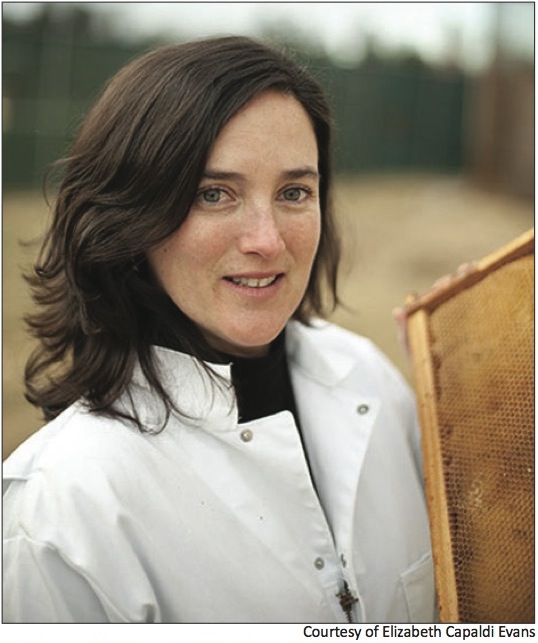Christina Oddo
Managing Editor
Associate Professor of Biology and Animal Behavior Elizabeth Capaldi Evans is currently researching honey bees along with a team of University students. The research revolves around the study of honey bee viral infections, pesticides, and the behaviors of the bees.
Evans began this particular research project as a collaboration with Associate Professor of Biology Marie Pizzorno, a molecular virologist. Both scientists use different techniques to pose questions about bee viruses.
“Our research is done in conjunction with several professors in biology,” Renata Mammone ’15, student researcher said. “My experiment, which involved Jean Rieuthavorn ’14, began over this past summer. It examines the effect of chronic exposure of the pesticide imidacloprid on levels of deformed wing virus (DWV) in honey bees. DWV has been identified as a potential cause of chronic bee health problems, including the so-called Colony Collapse Disorder, among other things.”
Evans explained and demonstrated what occurs in the lab. First, the students put on gear and head outside to two bee colonies, each a tower of wooden boxes with 60,000 to 80,000 worker bees, including one queen bee. The researchers take a comb of bee brood out of the colonies, remove the adult bees, and put it in an emergence cage which is then placed in an incubator. They then make mini colonies by putting day-old adult bees into a small, wooden cage. Evans, Mammone, and Rieuthavorn can easily move the day-old bees around as they cannot yet fly or sting.
The microcolonies are then divided into three treatment groups. The first group of bees receives no treatment. The experimental group receives an injection of a virus and a sham group receives an injection without a virus. These three groups are duplicated, and each is fed either food with no pesticides, food with low levels of pesticide, or food with high levels of pesticides.
The results of this experiment should answer how a virus affects the bees’ ability to resist pesticides. Bee health could be be affected by both exposures to pesticides and to the virus. One of the more interesting comparisons between microcolony groups includes the one between bees with a background level of the virus and bees that receive the dose of the virus. The researchers carefully observe and make note of the behavioral changes (speed, nature of interactions) as a result of these experimental groups.
There are physical implications of the virus too. When bees catch the virus as larvae, they may emerge as an adult with crumpled wings. But other bees can have the virus without any physical symptoms. If a bee gets the virus as an adult, crumpled wings will not be evident. The physical presence of this deformity lets the beekeeper know that the colony is sick.
The virus can be transmitted through mites, which feed on the larval bees, or through food-to-food transfer with another bee. It can also be transferred from mother to egg, but some bees pick up the virus while foraging (from a flower, for example).
“The best part of this research is the fact that there’s something new to learn everyday,” Rieuthavorn said. “I’m constantly kept on my toes because there’s still so much to learn about honey bees.”
The results of this research are not yet complete but a group of students and faculty are working to measure the amount of virus in bees from each microcolony.
“Finding a relationship between sublethal doses of such a common pesticide and its effect on bee viruses could be huge,” Mammone said. “For the rest of this semester, we will be processing data gathered over the course of the summer from this experiment. With the help of Dr. Pizzorno, the bodies of the bees will be put through a process known as PCR (polymerase chain reaction) to quantify the amount of virus in the bees.”
Evans shared her knowledge about the lives of bees, especially based on sex distinctions, reproductive needs, and life expectancies. Aging, for example, depends on the season. A bee born in the summer will only live for four or five weeks. If a bee is born later in the year, it will stay in the hive all winter and survive.
The bees change their jobs throughout their lives. As an adult, the bees take care of their younger sisters. The middle-aged bees clean the hive and wax. The older bees finally leave the hive and become foragers. These bees can travel as far as 10 miles away, and can learn how to get back home, despite the fact that they had never previously seen the light of day.
“I think bee behavior is immensely interesting,” Mammone ’15 said. “I could watch them for hours; they all have different jobs, and can communicate chemically and physically to coordinate an entire hive.”
The differences between behaviors based on sex are notable. The females are the masters of the honeybee society. The males, or drones, solely live to mate with the other queen bees. Each colony is 95 percent composed of females. By winter, there are no drones. Although they are bigger than the female workers, these bees do not even shiver, and therefore become a waste of space in the hive (asking for food, not providing warmth, etc.).
How a queen bee is made is part of an innate process that occurs in the hive. The female eggs are given extra food as young larvae, and because of this difference in the larval environment, the animal’s gene expression is altered. Whichever queen emerges into the hive first becomes the queen for the colony. The first emerged queen will seek out other queens while they are growing; she will sting and kill the others. If two queens emerge simultaneously, the bees fight, leaving one queen alive. The queen is always bigger in size than the worker bees, and can be more easily identified.
Since the decision to sting could end a worker bee’s life, they will only sting as a defense mechanism, and the queen, with her pointy abdomen, stings only for mating purposes; for the worker, this stinger is a modified egg-layer.
Evans and Pizzorno’s research is not the only study based on bees occurring on campus.
“From the Chemistry department, [Associate] Professor [of Chemistry] Rovnyak and Riju Akash ’14 are using bee bodies to learn more about NMR metabolomics, which involves running NMR on parts of or whole organisms, then uses mathematical models to test for significant differences,” Mammone said. “Grad student Matt Lamore is using basic choice testing to see if bumblebees have an innate preference for the smell of different strains of genetically modified tomatoes.”






















